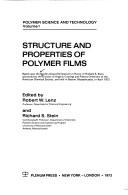| Listing 1 - 10 of 19 | << page >> |
Sort by
|
Book
Abstract | Keywords | Export | Availability | Bookmark
 Loading...
Loading...Choose an application
- Reference Manager
- EndNote
- RefWorks (Direct export to RefWorks)
Thermodynamique --- Thermodynamics. --- Adsorption --- Interfacial tension --- Adsorption --- Interfacial tension
Book
ISBN: 2225851913 Year: 1996 Publisher: Paris : Masson,
Abstract | Keywords | Export | Availability | Bookmark
 Loading...
Loading...Choose an application
- Reference Manager
- EndNote
- RefWorks (Direct export to RefWorks)
INTERFACIAL TENSION --- INTERFACIAL ENERGY --- POLYMERS --- PROPERTIES --- INTERFACIAL TENSION --- INTERFACIAL ENERGY --- POLYMERS --- PROPERTIES
Book
Year: 1980 Publisher: Zoetermeer : Betonvereniging,
Abstract | Keywords | Export | Availability | Bookmark
 Loading...
Loading...Choose an application
- Reference Manager
- EndNote
- RefWorks (Direct export to RefWorks)
Formwork construction --- Interfacial tension --- Mineral oils --- Formwork construction --- Interfacial tension --- Mineral oils

ISBN: 0306364018 1461589533 1461589517 9780306364013 Year: 1973 Volume: 1 Publisher: New York Plenum
Abstract | Keywords | Export | Availability | Bookmark
 Loading...
Loading...Choose an application
- Reference Manager
- EndNote
- RefWorks (Direct export to RefWorks)
678.01:532.61 <063> --- Plastic films --- -Plastics --- Plastics --- Plastics in packaging --- Protective coatings --- Thin films --- Properties. Defects. Constitution. Serviceability. Sampling. Analysis. Testing-:-Surface tension. Interfacial tension--Congressen --- Congresses --- Calendering --- Stein, Richard S. --- -Properties. Defects. Constitution. Serviceability. Sampling. Analysis. Testing-:-Surface tension. Interfacial tension--Congressen --- 678.01:532.61 <063> Properties. Defects. Constitution. Serviceability. Sampling. Analysis. Testing-:-Surface tension. Interfacial tension--Congressen --- -678.01:532.61 <063> Properties. Defects. Constitution. Serviceability. Sampling. Analysis. Testing-:-Surface tension. Interfacial tension--Congressen --- Plastic films - Congresses
Book
Year: 1959 Publisher: Paris : Dunod,
Abstract | Keywords | Export | Availability | Bookmark
 Loading...
Loading...Choose an application
- Reference Manager
- EndNote
- RefWorks (Direct export to RefWorks)
Viscosity. --- Sound-waves. --- Fluids --- Physical property --- Fluid flow --- Hydrostatics --- Compressible flow --- Floating bodies --- Analogies --- Thermodynamics --- Interfacial tension --- Atmospheric pressure --- Center of pressure --- Acoustic velocity --- Flow visualization --- Wave propagation --- Fluids --- Physical property --- Fluid flow --- Hydrostatics --- Compressible flow --- Floating bodies --- Analogies --- Thermodynamics --- Interfacial tension --- Atmospheric pressure --- Center of pressure --- Acoustic velocity --- Flow visualization --- Wave propagation

ISBN: 0471912875 Year: 1987 Volume: 16 Publisher: New York, NY ; Chichester : London : John Wiley ; Society of Chemical Industry,
Abstract | Keywords | Export | Availability | Bookmark
 Loading...
Loading...Choose an application
- Reference Manager
- EndNote
- RefWorks (Direct export to RefWorks)
Adhesieven --- Adhesives --- Adhésifs --- Agglutinants --- Bonding agents (Adhesives) --- Produits d'etancheite --- Sealing compounds --- Waterdichtheidsprodukten --- Produits d'étanchéité --- 678.061 --- 678.01:532.61 --- #WSCH:MACB --- Latex products. Compositions and mixings (e.g. lubricants, greases, paints, lacquers, adhesives) --- Properties. Defects. Constitution. Serviceability. Sampling. Analysis. Testing-:-Surface tension. Interfacial tension --- 678.01:532.61 Properties. Defects. Constitution. Serviceability. Sampling. Analysis. Testing-:-Surface tension. Interfacial tension --- 678.061 Latex products. Compositions and mixings (e.g. lubricants, greases, paints, lacquers, adhesives) --- Adhésifs --- Produits d'étanchéité --- Acrylic polymers --- Epoxy resins --- Polyamides --- Polyesters --- Polysiloxanes --- Polyurethanes
Book
ISBN: 3039211072 3039211064 Year: 2019 Publisher: MDPI - Multidisciplinary Digital Publishing Institute
Abstract | Keywords | Export | Availability | Bookmark
 Loading...
Loading...Choose an application
- Reference Manager
- EndNote
- RefWorks (Direct export to RefWorks)
It is well-known that colloid and interface science and petroleum production are inextricably linked. Whether in the reservoir, with its porous structure, or during recovery, crude oil is intimately associated with rock surfaces and with water, often in the form of emulsions. This situation leads to highly complex systems, comprising multiple colloids and interfaces, which require to be optimized if oil is to be recovered efficiently, both in terms of economic cost and with due concern for the environment. This book contains a compilation of contemporary research topics which illustrate various aspects of the importance of colloids and interfaces in crude oil recovery through modifying conditions between the rock, crude oil, and water in the reservoir, in order to achieve improved oil recovery. The specific topics covered relate both to conventional oils, in which waterflooding is the most common secondary and tertiary means of recovery, and to non-conventional heavy oil and natural bitumen, which require thermal recovery methods, owing to their high viscosity.
n/a --- multicomponent ion exchange --- alcohols --- polymer-enhanced foam --- low salinity waterflooding --- heavy oil --- cyclodextrins --- SAGD --- nanoparticle fluids --- CO2 foam --- in-situ rheology --- surfactants --- Pickering emulsions --- enhanced oil recovery --- emulsions --- inclusion complexes --- petroleum --- Bacillus halodurans --- non-Newtonian flow in porous medium --- oil recovery --- Bacillus firmus --- oil film displacement --- surface and interfacial tension --- naphthenic acid --- Microbial Enhanced Oil Recovery --- recovery factor --- thermal recovery --- heavy oil and bitumen --- SAG --- colloid and interfacial science --- metal ion interactions --- porous media --- optical video microscopy --- microfluidics --- spore forming bacteria --- interfacial complexation --- electric double layer --- dynamic interfacial tension --- polymer flooding --- wettability --- polymers --- fluid–fluid interactions --- interfaces --- waterflooding --- oil sands --- EOR --- contact angles --- wettability alteration --- biotransformation --- monolayer --- asphaltene --- petroleum colloids --- surface charge --- heavy oil recovery --- fluid-fluid interactions
Book
Year: 2021 Publisher: Basel, Switzerland MDPI - Multidisciplinary Digital Publishing Institute
Abstract | Keywords | Export | Availability | Bookmark
 Loading...
Loading...Choose an application
- Reference Manager
- EndNote
- RefWorks (Direct export to RefWorks)
The oil industry has, in the last decade, seen successful applications of nanotechnology in completion systems, completion fluids, drilling fluids, and in improvements of well constructions, equipment, and procedures. However, very few full field applications of nanoparticles as an additive to injection fluids for enhanced oil recovery (EOR) have been reported. Many types of chemical enhanced oil recovery methods have been used in fields all over the world for many decades and have resulted in higher recovery, but the projects have very often not been economic. Therefore, the oil industry is searching for a more efficient enhanced oil recovery method. Based on the success of nanotechnology in various areas of the oil industry, nanoparticles have been extensively studied as an additive in injection fluids for EOR. This book includes a selection of research articles on the use of nanoparticles for EOR application. The articles are discussing nanoparticles as additive in waterflooding and surfactant flooding, stability and wettability alteration ability of nanoparticles and nanoparticle stabilized foam for CO2-EOR. The book also includes articles on nanoparticles as an additive in biopolymer flooding and studies on the use of nanocellulose as a method to increase the viscosity of injection water. Mathematical models of the injection of nanoparticle-polymer solutions are also presented.
Technology: general issues --- nanomaterials --- pore throat size distribution --- mercury injection capillary pressure --- interfacial tension --- contact angle --- enhanced oil recovery --- surfactant --- nanoparticle --- chemical flooding --- nanocellulose --- cellulose nanocrystals --- TEMPO-oxidized cellulose nanofibrils --- microfluidics --- biopolymer --- silica nanoparticles --- nanoparticle stability --- reservoir condition --- reservoir rock --- crude oil --- nanoparticle agglomeration --- polymer flooding --- formation rheological characteristics --- polymer concentration --- recovery factor --- mathematical model --- nanoparticles --- foam --- CO2 EOR --- CO2 mobility control --- nanotechnology for EOR --- nanoparticles stability --- polymer-coated nanoparticles --- core flood --- EOR --- wettability alteration --- nanoparticle-stabilized emulsion and flow diversion --- nanomaterials --- pore throat size distribution --- mercury injection capillary pressure --- interfacial tension --- contact angle --- enhanced oil recovery --- surfactant --- nanoparticle --- chemical flooding --- nanocellulose --- cellulose nanocrystals --- TEMPO-oxidized cellulose nanofibrils --- microfluidics --- biopolymer --- silica nanoparticles --- nanoparticle stability --- reservoir condition --- reservoir rock --- crude oil --- nanoparticle agglomeration --- polymer flooding --- formation rheological characteristics --- polymer concentration --- recovery factor --- mathematical model --- nanoparticles --- foam --- CO2 EOR --- CO2 mobility control --- nanotechnology for EOR --- nanoparticles stability --- polymer-coated nanoparticles --- core flood --- EOR --- wettability alteration --- nanoparticle-stabilized emulsion and flow diversion
Book
Year: 2021 Publisher: Basel, Switzerland MDPI - Multidisciplinary Digital Publishing Institute
Abstract | Keywords | Export | Availability | Bookmark
 Loading...
Loading...Choose an application
- Reference Manager
- EndNote
- RefWorks (Direct export to RefWorks)
Droplet microfluidics has dramatically developed in the past decade and has been established as a microfluidic technology that can translate into commercial products. Its rapid development and adoption have relied not only on an efficient stabilizing system (oil and surfactant), but also on a library of modules that can manipulate droplets at a high-throughput. Droplet microfluidics is a vibrant field that keeps evolving, with advances that span technology development and applications. Recent examples include innovative methods to generate droplets, to perform single-cell encapsulation, magnetic extraction, or sorting at an even higher throughput. The trend consists of improving parameters such as robustness, throughput, or ease of use. These developments rely on a firm understanding of the physics and chemistry involved in hydrodynamic flow at a small scale. Finally, droplet microfluidics has played a pivotal role in biological applications, such as single-cell genomics or high-throughput microbial screening, and chemical applications. This Special Issue will showcase all aspects of the exciting field of droplet microfluidics, including, but not limited to, technology development, applications, and open-source systems.
Technology: general issues --- FADS --- emulsification --- droplet coalescence --- enzyme engineering --- synthetic biology --- droplet formation --- phase field model --- interfacial tension --- glass capillary microfluidic device --- fluidic mixer --- air bubble --- 3D printing --- microcapsules --- double-emulsion drops --- osmotic pressure --- ultra-thin-shell --- microfluidics --- droplet array --- microvalve --- droplets --- lock-in detection --- real-time calibration --- homogeneous immunoassay --- on-chip mergers --- pneumatic valves --- programmable droplet formation --- dilutions --- Microfluidics --- drug combinations --- screening --- droplet microfluidics --- sorting --- passive sorting --- photo-tag --- FADS --- emulsification --- droplet coalescence --- enzyme engineering --- synthetic biology --- droplet formation --- phase field model --- interfacial tension --- glass capillary microfluidic device --- fluidic mixer --- air bubble --- 3D printing --- microcapsules --- double-emulsion drops --- osmotic pressure --- ultra-thin-shell --- microfluidics --- droplet array --- microvalve --- droplets --- lock-in detection --- real-time calibration --- homogeneous immunoassay --- on-chip mergers --- pneumatic valves --- programmable droplet formation --- dilutions --- Microfluidics --- drug combinations --- screening --- droplet microfluidics --- sorting --- passive sorting --- photo-tag
Periodical
Abstract | Keywords | Export | Availability | Bookmark
 Loading...
Loading...Choose an application
- Reference Manager
- EndNote
- RefWorks (Direct export to RefWorks)
Colloids --- Surface chemistry --- Surface Properties. --- Colloids. --- Surface chemistry. --- Chemistry, Surface --- Interfaces, Chemistry of --- Surface phenomena --- Surfaces (Chemistry) --- Chemistry, Physical and theoretical --- Capillarity --- Surface energy --- Surface tension --- Surfaces (Physics) --- Dispersoids --- Gels --- Hydrogels --- Sols --- Amorphous substances --- Diffusion --- Matter --- Micelles --- Particles --- Rheology --- Solution (Chemistry) --- Hydrocolloids --- Colloid --- Hydrocolloid --- Liquid Crystals --- Properties, Surface --- Property, Surface --- Surface Property --- Properties --- colloids --- interface science --- functional materials --- surface science --- nanomedicine --- soft matter --- Surface Properties --- Surface Tension --- Interfacial Force --- Interfacial Tension --- Surface Tensions --- Tension, Surface --- Tensions, Surface
| Listing 1 - 10 of 19 | << page >> |
Sort by
|

 Search
Search Feedback
Feedback About UniCat
About UniCat  Help
Help News
News